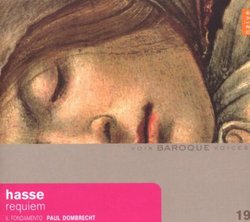| All Artists: Il Fondamento Title: Hasse: Requiem Members Wishing: 1 Total Copies: 0 Label: Naive Original Release Date: 1/1/2008 Re-Release Date: 5/27/2008 Genre: Classical Styles: Opera & Classical Vocal, Chamber Music, Historical Periods, Baroque (c.1600-1750), Classical (c.1770-1830), Early Music Number of Discs: 1 SwapaCD Credits: 1 UPC: 709861304646 |
Search - Il Fondamento :: Hasse: Requiem
CD Details |
CD ReviewsOpen the Gates Wide for This Cortege! Giordano Bruno | Wherever I am, I am. | 08/23/2008 (5 out of 5 stars) "Augustus II "the Strong" was quite a dude. Prince Elector of Saxony and King of Poland, he gets most of the credit for building Dresden into the architectural and musical capital it was in the 18th Century. His sobriquet was given him not only for his ability to bend and snap horseshoes in his bare hands but also for his polyphiloprogenitivity. (I've stored that word up for years, waiting for this moment.) He did gallop his realm into crisis, it must be confessed, but it was a wild ride. He also ate himself into diabetes and got enormously fat before his sudden death in 1763. There's an ample biography of him on wikipedia, worth a look.
The funeral of Augustus II was the specific occasion for the composition of the Requiem in C major by Johan Adolf Hasse (1699-1783). The Elector's patronage had made Hasse perhaps the most successful and widely known composer of the 18th Century. Hasse paid his royal friend back with a triumphant musical farewell. Just the choice of C major as the key tells a lot; this is not a requiem of grief and penitence. Instead it's a festive procession through the open gates of heaven, richly caparisoned with joy and pomp. Gus the Strong would have loved it. It's also a superb oratorio/cantata, evidence that Hasse's huge success was fully deserved. The forces required are large: full strings and chorus plus pairs of flutes, horns, oboes, trumpets, bassoons, organ, and tympani, with four vocal soloists. The music comprises 21 movements, with maximum variety and color. It was an immense success, as proven by the number of copies that have survived in libraries across Europe. Gus was buried in Poland, by the way, where his memory is still execrated, but his heart was buried in Dresden. Also performed on this CD is Hasse's Miserere in E minor, a piece that sounds at times quite a lot like Mozart's Requiem. It's heart-felt, dolorous, and penitential, but wends gracefully toward consolation. Check the dates on Hasse's works and you'll be surprised to find that he was writing "Sturm und Drang" romanticism while Haydn and Mozart were toying with divertimenti. Hasse was enormously productive - there must have been productivity juices in the water supplies of 18th C Europe - and he lived to the age of 84. His music is still not performed as often or as widely as it deserves, and his dozens of operas, I predict, will be the next "discovery" in European theaters. This performance by the Belgian ensemble Il Fondamento brims with energy and insight. A well-trained period musician might notice a few technical blemishes but would pay them no regard in the presence of such vivid musicality. Especially wonderful are the many duet passages for soprano and alto, sung with luscious harmony by Greta De Reyghere and Susanna Moncayo von Hase. Conductor Paul Dombrecht achieves brilliance also by knitting together the multifarious recitativos, arias, and choruses into a work of monumental unity. The case has been made, music lovers, with this recording and other CDs by 'Il Seminario Musicale' that Johann Adolf Hasse was, and is, a composer of the highest rank." |

